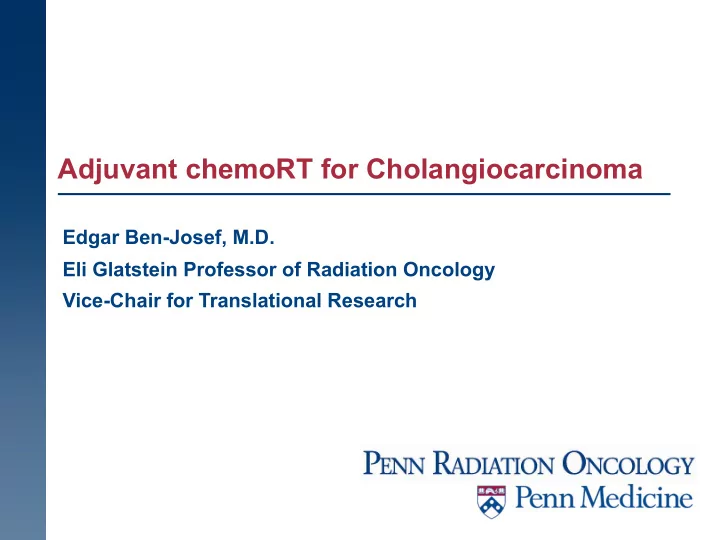

Adjuvant chemoRT for Cholangiocarcinoma Edgar Ben-Josef, M.D. Eli Glatstein Professor of Radiation Oncology Vice-Chair for Translational Research
Rationale for Radiotherapy in CC and Gallbladder Cancer Disease Spread w Direct: a long the biliary tree and radially w Nodal: w Perihilar and periportal nodes w Along the common bile duct to the retropancreaticoduodenal lymph nodes Patterns of First Failure w Local regional failure rates are high w Hilar ~40% w Distal ~25% w Gallbladder ~20-40% w Isolated LRF is ~10-15% 2
Lack of Evidence is not Evidence of Lack (of Effect) w No prospective randomized trials are available that examined the effect of adjuvant radiotherapy. w Numerous retrospective studies of adjuvant therapy have shown mixed results w Horgan et al JCO 2011 • Meta-analysis 20 series • Adjuvant chemotherapy, radiotherapy, or CRT compared with curative-intent surgery alone • IHCC, EHCC, Gallbladder cancer • Twenty studies involving 6,712 patients • Those receiving CT or CRT derived statistically significant benefit (OR, 0.39, 0.61, respectively); No benefit for RT alone. • The greatest benefit for AT was in those with +LN disease (OR, 0.49) and R1 disease (OR, 0.36) 3
Rationale for radiotherapy in cholangiocarcinoma (SEER) EHCC IHCC Shinohara ET, et al. Radiotherapy is associated with improved survival in adjuvant and palliative treatment of IHCC/EHCC. Int J Radiat Oncol Biol Phys. 2008/2009 4
SWOG S0809 Eligibility: • Phase II trial of adjuvant chemo followed by chemoRT • EHCC and GB Cancer • Stage pT2-4 or N+ or R1 • S/P radical resection; performance status 0 to 1 Treatment: • Chemotherapy (gemcitabine and capecitabine x 4 cycles) • Chemoradiation – 45 Gy to regional LNs, 54-59.4 Gy to tumor bed – 3DCRT or IMRT – Concurrent capecitabine 5
SWOG 0809 Results: – 79 patients ○ R0, n = 54; R1, n = 25 ○ Hilar CC 49%, Distal 17%, GBCA, 32% – 2-year OS 65% (67% R0; 60% R1 patients) – Median overall survival was 35 months – Grade 3 and 4 adverse effects were observed in 52% and 11% of patients, respectively (neutropenia 44%) Conclusion: • Well tolerated, efficacious regimen option 6
DFS and Overall Survival by resection margin SWOG 0809 SWOG 0809 Hilar Komaya et.al Komaya et.al Surgery 2018 Surgery 2018 7
Recurrence After Curative Resection of Perihilar CC w 402 patients (R0, n = 340; R1, n = 62) resected 2001- 2012 w Minimal use of adjuvant therapy, mostly in R1 pts Komaya et. Al., Surgery 2018 8
OS and DFS by disease site 9
Gallbladder Cancer Patterns of (first) Failure w 70 patients s/p radical cholecystectomy and LN dissection; T2 or higher w Median F/U 23 months w Locoregional – 41% (isolated LR 19%) w Distant (with or without LR) – 40%) Kim TG., Radiation Oncology J 2017 35(4):359-367 10 10
Adjuvant Chemoradiotherapy is Associated with Improved Survival for Patients with Resected Gallbladder Carcinoma Kim et al., Ann Surg Oncol (2018) 25:255–264 11 11
Conclusions w Locoregional relapse rates are high after curative resection of CC and GB cancer w Adjuvant radiotherapy improves local control and survival • Retrospective reviews, meta analyses, large database analysis, a single phase 2 study (no prospective phase 3 data) w Some adjuvant chemotherapy regimens improve DFS (capecitabine) w One modality does not exclude the other – there is no reason not to use both 12 12
The 15 th Annual Meeting of the International Society of Gastrointestinal Oncology The 2018 Gastrointestinal Oncology Conference
Recommend
More recommend